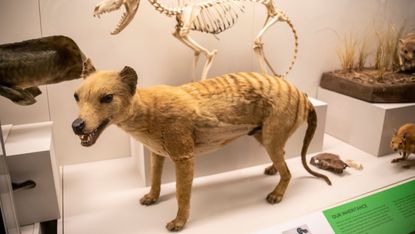Scientists a step closer to resurrecting extinct Tasmanian tiger
New study marks the first time RNA has been recovered from an extinct species

A free daily digest of the biggest news stories of the day - and the best features from our website
Thank you for signing up to TheWeek. You will receive a verification email shortly.
There was a problem. Please refresh the page and try again.
Scientists have taken another step towards the resurrection of the Tasmanian tiger with the first successful recovery of RNA from an extinct species.
RNA is the genetic material present in all living cells and has structural similarities to DNA. The discovery, published in the scientific journal Genome Research, offers "hope that RNA locked up in the world's museum collections could provide new insights into long-dead species", said Nature.
The Tasmanian tiger – also known as the thylacine – was, despite the name, a carnivorous marsupial that lived on the island of Tasmania, Australia. The last known Tasmanian tiger died in captivity in 1936 and the animal was classified as officially extinct in 1982. The material in the new study was extracted from the desiccated skin and muscle of a Tasmanian tiger, stored since 1891 at a museum in Stockholm.
Subscribe to The Week
Escape your echo chamber. Get the facts behind the news, plus analysis from multiple perspectives.

Sign up for The Week's Free Newsletters
From our morning news briefing to a weekly Good News Newsletter, get the best of The Week delivered directly to your inbox.
From our morning news briefing to a weekly Good News Newsletter, get the best of The Week delivered directly to your inbox.
"RNA gives you the chance to go through the cell, the tissues and find the real biology that has been preserved in time for that animal, the thylacine species, right before they died," said lead study author Emilio Mármol Sánchez, a computational biologist at the Centre for Palaeogenetics and SciLifeLab in Stockholm.
It is the first time RNA has been recovered from an extinct species and the technique "may help our understanding of virus evolution and further controversial de-extinction efforts", said New Scientist. De-extinction is the process of recreating versions of extinct species using gene-editing tools and existing organisms as hosts.
While de-extinction wasn't the goal of Sánchez's team's research, "a better understanding of the Tasmanian tiger's genetic makeup could help recently launched efforts to bring back the animal in some form", said CNN.
"We had previously thought only DNA remained in old museum and ancient samples," said Andrew Pask, from the University of Melbourne, who is part of a team looking at de-extinction of the species. "This can tell us about the function of genes in an extinct animal."

Continue reading for free
We hope you're enjoying The Week's refreshingly open-minded journalism.
Subscribed to The Week? Register your account with the same email as your subscription.
Sign up to our 10 Things You Need to Know Today newsletter
A free daily digest of the biggest news stories of the day - and the best features from our website
Jamie Timson is the UK news editor, curating The Week UK's daily morning newsletter and setting the agenda for the day's news output. He was first a member of the team from 2015 to 2019, progressing from intern to senior staff writer, and then rejoined in September 2022. As a founding panellist on “The Week Unwrapped” podcast, he has discussed politics, foreign affairs and conspiracy theories, sometimes separately, sometimes all at once. In between working at The Week, Jamie was a senior press officer at the Department for Transport, with a penchant for crisis communications, working on Brexit, the response to Covid-19 and HS2, among others.
-
 Ben Fountain's 6 favorite books about Haiti
Ben Fountain's 6 favorite books about HaitiFeature The award-winning author recommends works by Marie Vieux-Chauvet, Katherine Dunham and more
By The Week Staff Published
-
 6 picturesque homes in apartments abroad
6 picturesque homes in apartments abroadFeature Featuring a wall of windows in Costa Rica and a luxury department store-turned-home in New Zealand
By The Week Staff Published
-
 Why 2023 has been the year of strikes and labor movements
Why 2023 has been the year of strikes and labor movementsThe Explainer From Hollywood to auto factories, workers are taking to the picket lines
By Justin Klawans Published
-
 Fossils uncovered in Australia are 107 million-year-old pterosaurs bones, scientists say
Fossils uncovered in Australia are 107 million-year-old pterosaurs bones, scientists saySpeed Read
By Devika Rao Published
-
 'A tremendous result': Coin-sized radioactive capsule located after 6-day hunt
'A tremendous result': Coin-sized radioactive capsule located after 6-day huntSpeed Read
By Devika Rao Published
-
 Why Australia doesn't want to list the Great Barrier Reef as endangered
Why Australia doesn't want to list the Great Barrier Reef as endangeredSpeed Read
By Devika Rao Published





